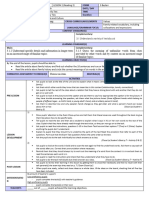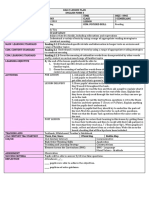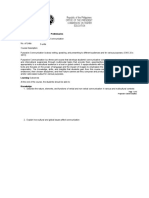Lesson 65
Lesson 65
Uploaded by
Madam Rushila RahimiCopyright:
Available Formats
Lesson 65
Lesson 65
Uploaded by
Madam Rushila RahimiOriginal Title
Copyright
Available Formats
Share this document
Did you find this document useful?
Is this content inappropriate?
Copyright:
Available Formats
Lesson 65
Lesson 65
Uploaded by
Madam Rushila RahimiCopyright:
Available Formats
WEEK/LESSON NO.
LESSON 65 (Listening 13) FORM 3 Bestari
SUBJECT English DATE / DAY
UNIT 7 TIME
TOPIC Extreme Situations Duration
THEME Health and Environment
MAIN SKILL Listening CROSS-CURRICULAR ELEMENTS Entrepreneurship
21ST CENTURY LEARNING Choose an item. Vocabulary related to extreme
TECHNIQUE(S) LANGUAGE/GRAMMAR FOCUS: situations
CONTENT STANDARD(S)
Main: Complementary:
1.1 Understand meaning in a variety of familiar contexts 3.1 Understand a variety of texts by using a range of appropriate
reading strategies to construct meaning
LEARNING STANDARD(S)
Main: Complementary:
1.1.4 Understand independently longer sequences of classroom 3.1.3 Guess the meaning of unfamiliar words from clues
instructions provided by other words and by context on an increased range
of familiar topics
LEARNING OBJECTIVE(S)
By the end of the lesson, pupils should be able to:
Read five incomplete sentences and choose two words to fill the gaps in each sentence correctly.
Listen to the recording and write down four words that are spelt based on the recording.
Close-Up Student’s Book, p.88
FORMATIVE ASSESSMENT TECHNIQUE(S Choose an item. MATERIAL(S) Close-Up Teacher’s Book, p. 74-75
Student’s Book Audio CD
ACTIVITIES
Ask pupils to look at the picture at the bottom of page 88 and ask them what extreme situation it shows
PRE-LESSON
Encourage them to come up with as many ideas as possible about why the people might be walking across the desert.
1)
Read the words in the yellow word banks to pupils and ask them to repeat them. Correct their pronunciation where
necessary.
Ask pupils to read the instructions and elicit that they should cross out the word in each set of three that doesn't
complete the sentence so that the two соггесt words are left for them to study.
Remind pupils to read through the sentences carefully and to pay attention to the words immediately before and after
the gaps as well as to the form of the words in the boxes.
Some pupils may find a few of the highlighted words difficult. While completing the sentences, they can guess their
meaning and decide if they fit in the gap.
LESSON
Ask pupils to do the task individually but check answers as a class. (Student’s Book p.88– Activity A)
DEVELOPMENT 2)
Give pupils a minute to practise saying the alphabet to their partner. Then practise as a class. Correct their
pronunciation where necessary.
Play the recording once all the way through and ask pupils to write their answers. Then ask pupils to compare their
answers with a partner.
Play the recording again and ask pupils to check the answers and to fill in any missing answers.
Check the answers as a class by asking a student to write the words on the board as the other pupils so spell them out.
(Student’s Book p.88 – Activity B)
Ask pupils to identify with their talk partner(s) at least one new word or expression that they have learned in relation
POST-LESSON to the lesson topic.
When pupils are ready, collect and share words/expressions as a whole class.
By amount of teacher’s support:
Low-proficiency pupils
DIFFERENTIATIO
- pupils complete the tasks(s) with teacher’s guidance
N High-proficiency pupils
- pupils complete the tasks(s) on their own
TEACHER’S _____ out of ______ pupils achieved the learning objectives.
REFLECTION _____ pupils were given remedial treatment.
You might also like
- SK Year 6 Cefr Unit 7 - Music and SongDocument25 pagesSK Year 6 Cefr Unit 7 - Music and SongMAJJI ATHI LAKSHMY A/P SURYANARAYANAN KPM-GuruNo ratings yet
- Top-Down Model TheoryDocument14 pagesTop-Down Model Theorymaria joy asirit100% (1)
- Unit 6 Time OutDocument14 pagesUnit 6 Time OutAziah AzizNo ratings yet
- Poetic Devices Easter Egg HuntDocument7 pagesPoetic Devices Easter Egg HuntNick KharshiingNo ratings yet
- Lesson 79Document1 pageLesson 79Madam Rushila RahimiNo ratings yet
- Lesson 93Document1 pageLesson 93Madam Rushila RahimiNo ratings yet
- Lesson 2 English Form 3 Close UpDocument2 pagesLesson 2 English Form 3 Close Upg-28512796No ratings yet
- Lesson 78Document1 pageLesson 78Khairul HafiziNo ratings yet
- LESSON 3 TTDocument2 pagesLESSON 3 TTZANARIAH BINTI JAAPAR MoeNo ratings yet
- 8.11, Tue f5Document1 page8.11, Tue f5Siti AthirahNo ratings yet
- Lesson 26Document1 pageLesson 26farah famiNo ratings yet
- Lesson 6Document1 pageLesson 6g-25140090No ratings yet
- p84 Activity 1 & 2) : Teachers' HandoutDocument1 pagep84 Activity 1 & 2) : Teachers' HandoutFaryz Tontok Tinan 오빠No ratings yet
- p84 Activity 1 & 2) : Teachers' HandoutDocument1 pagep84 Activity 1 & 2) : Teachers' HandoutFaryz Tontok Tinan 오빠No ratings yet
- SK Year 6 Cefr Unit 6 - How Is It MadeDocument28 pagesSK Year 6 Cefr Unit 6 - How Is It MadeMAJJI ATHI LAKSHMY A/P SURYANARAYANAN KPM-GuruNo ratings yet
- 31 Tuesday/ 25 August 2020 3D 11:20 Am - 12:30 PMDocument1 page31 Tuesday/ 25 August 2020 3D 11:20 Am - 12:30 PMATIKAHNo ratings yet
- Is Used To Refer To Crime Fiction.) .: English DownloadDocument1 pageIs Used To Refer To Crime Fiction.) .: English DownloadSiti AthirahNo ratings yet
- Choose An Item.: Content StandardDocument9 pagesChoose An Item.: Content StandardSangeetaNo ratings yet
- Year 5 Daily Lesson Plans: By:MissashDocument6 pagesYear 5 Daily Lesson Plans: By:MissashAbu AliNo ratings yet
- Lesson 107Document2 pagesLesson 107Madam Rushila RahimiNo ratings yet
- New SJK Year 6 Cefr Unit 4 - Cool JobsDocument11 pagesNew SJK Year 6 Cefr Unit 4 - Cool JobsVIKNESWARI A/P SEKHAR MoeNo ratings yet
- Student's Book p59-60 Teacher's Book p59-60: A Lot of Homework Tonight, .)Document2 pagesStudent's Book p59-60 Teacher's Book p59-60: A Lot of Homework Tonight, .)Siti AthirahNo ratings yet
- Full Blast Plus 4: Student's Book p69-70 Teacher's Book p69-70Document2 pagesFull Blast Plus 4: Student's Book p69-70 Teacher's Book p69-70Siti Athirah0% (1)
- Year 2daily Lesson Plans: Skills Pedagogy (Strategy/Activity)Document5 pagesYear 2daily Lesson Plans: Skills Pedagogy (Strategy/Activity)Farrah NazNo ratings yet
- Lesson Plan Observe IsppkDocument6 pagesLesson Plan Observe IsppkNURUL SYAZANA BINTI ZAINUDDIN KPM-GuruNo ratings yet
- Lesson 4 English Form 3 Close UpDocument1 pageLesson 4 English Form 3 Close Upg-28512796No ratings yet
- Year 2 Daily Lesson Plans: Skills Pedagogy (Strategy/Activity)Document5 pagesYear 2 Daily Lesson Plans: Skills Pedagogy (Strategy/Activity)Farrah NazNo ratings yet
- 1.9 ThuDocument2 pages1.9 ThuSiti AthirahNo ratings yet
- Pulse 2 Student's Book p.62 Teacher's Book p.62Document5 pagesPulse 2 Student's Book p.62 Teacher's Book p.62siti aininaNo ratings yet
- Lesson Plan EditDocument1 pageLesson Plan EditREHEDDILLY LEONGVUI FOH MoeNo ratings yet
- Unit 8 ImageDocument20 pagesUnit 8 ImageSainah ManigothNo ratings yet
- Year 5daily Lesson Plans Success Criteria Pupils Can 1. Listen and Underline 4 Correct Words. 2. Read and Fill in at Least 6 Blanks CorrectlyDocument8 pagesYear 5daily Lesson Plans Success Criteria Pupils Can 1. Listen and Underline 4 Correct Words. 2. Read and Fill in at Least 6 Blanks Correctlyjulie ayobNo ratings yet
- Year 4 Daily Lesson Plans: By:MissashDocument6 pagesYear 4 Daily Lesson Plans: By:MissashAnyss Ayuni100% (1)
- 20.6.22 (Mon)Document4 pages20.6.22 (Mon)Siti AthirahNo ratings yet
- Lesson 6 TS25Document8 pagesLesson 6 TS25Eyzma MuradNo ratings yet
- Grammar Space 3 Teacher - S Guide PDFDocument85 pagesGrammar Space 3 Teacher - S Guide PDFJasmin Manio67% (3)
- Y2 Week 17Document5 pagesY2 Week 17Anonymous AlNYJDVNo ratings yet
- English Lesson Plan Year 6 Cefr Unit 7Document2 pagesEnglish Lesson Plan Year 6 Cefr Unit 7M DNo ratings yet
- Y2 Week 26Document5 pagesY2 Week 26Anonymous AlNYJDVNo ratings yet
- 2 - 21 March 24Document2 pages2 - 21 March 24g-52405257No ratings yet
- Bargain Hunter) : English DownloadDocument4 pagesBargain Hunter) : English Downloadizti_azrah4981No ratings yet
- Ng. Repeat As RequiredDocument21 pagesNg. Repeat As RequiredRasyidah ZakariaNo ratings yet
- Latest Form 3 Lesson Plan (Cefr/kssm English Daily Lesson Plan) RPH Bahasa Inggeris Sekolah Menengah Tingkatan 3 TerkiniDocument2 pagesLatest Form 3 Lesson Plan (Cefr/kssm English Daily Lesson Plan) RPH Bahasa Inggeris Sekolah Menengah Tingkatan 3 Terkinierfolg.prominenceNo ratings yet
- Form 3 Lesson 2Document1 pageForm 3 Lesson 2Ami Amnaida HamidNo ratings yet
- Lesson 8Document2 pagesLesson 8g-25140090No ratings yet
- Lesson 99Document1 pageLesson 99Orked MerahNo ratings yet
- 4 - 2 April 24Document3 pages4 - 2 April 24g-52405257No ratings yet
- Latest Form 5 Lesson Plan (Cefr/kssm English Daily Lesson Plan) RPH Bahasa Inggeris Sekolah Menengah Tingkatan 5 TerkiniDocument2 pagesLatest Form 5 Lesson Plan (Cefr/kssm English Daily Lesson Plan) RPH Bahasa Inggeris Sekolah Menengah Tingkatan 5 Terkinierfolg.prominenceNo ratings yet
- Y2 Week 25Document5 pagesY2 Week 25Anonymous AlNYJDVNo ratings yet
- Lesson 58Document1 pageLesson 58Madam Rushila RahimiNo ratings yet
- Content StandardDocument3 pagesContent StandardvoonNo ratings yet
- Week 9 (6-10 May 2024)Document13 pagesWeek 9 (6-10 May 2024)Norain AfzanNo ratings yet
- English Download Student's Book p64Document1 pageEnglish Download Student's Book p64Siti Athirah100% (1)
- Y3 W25 LPDocument5 pagesY3 W25 LPzalinaNo ratings yet
- Lesson 5Document1 pageLesson 5NOR HASIKIN BINTI TUAH KPM-GuruNo ratings yet
- Monday 280322Document4 pagesMonday 280322Dezzary LatiffNo ratings yet
- Year 4 Daily Lesson Plans: Skills Pedagogy (Strategy/Activity)Document5 pagesYear 4 Daily Lesson Plans: Skills Pedagogy (Strategy/Activity)julie ayobNo ratings yet
- Lesson Plan Form 3: by The End of The Lesson, Pupils CanDocument1 pageLesson Plan Form 3: by The End of The Lesson, Pupils CanAlbatross ArtemisiaNo ratings yet
- Choose An Item.: Pulse 2 Student's Book p.67 Teacher's Book p.67Document6 pagesChoose An Item.: Pulse 2 Student's Book p.67 Teacher's Book p.67Neyna ShaNo ratings yet
- 42 - 7 Feb 24Document5 pages42 - 7 Feb 24g-52405257No ratings yet
- English Lesson Plan Year 3Document13 pagesEnglish Lesson Plan Year 3g-76526543No ratings yet
- Teaching English to Young Learners: Teacher DevelopmentFrom EverandTeaching English to Young Learners: Teacher DevelopmentRating: 4 out of 5 stars4/5 (5)
- Lesson 100Document1 pageLesson 100Madam Rushila RahimiNo ratings yet
- Lesson 107Document2 pagesLesson 107Madam Rushila RahimiNo ratings yet
- Lesson 72Document2 pagesLesson 72Madam Rushila RahimiNo ratings yet
- Lesson 51Document1 pageLesson 51Madam Rushila RahimiNo ratings yet
- Lesson 58Document1 pageLesson 58Madam Rushila RahimiNo ratings yet
- Chapter III (Continued)Document14 pagesChapter III (Continued)Thach AnhNo ratings yet
- English Language - Syllabus - Grade 12Document65 pagesEnglish Language - Syllabus - Grade 12hawi tadeleNo ratings yet
- Present Simple Vs Present ContinuousDocument3 pagesPresent Simple Vs Present ContinuousIván PérezNo ratings yet
- Defining Vocabulary in ContextDocument6 pagesDefining Vocabulary in ContextNguyễn Thế SơnNo ratings yet
- GE 1 - Mathematics in The Modern WorldDocument15 pagesGE 1 - Mathematics in The Modern WorldKervi RiveraNo ratings yet
- Persuasive Writing - Advertisement - Model Analysis PDFDocument4 pagesPersuasive Writing - Advertisement - Model Analysis PDFRachelleChellaBarnardNo ratings yet
- Gerunds Used As Objects: Grammar WorksheetDocument4 pagesGerunds Used As Objects: Grammar WorksheetKaren Liseth Carvajal FigueroaNo ratings yet
- MasterClass Subtitling GuideDocument12 pagesMasterClass Subtitling GuideinfoNo ratings yet
- Present Perfect TenseDocument4 pagesPresent Perfect Tenseapi-304729893No ratings yet
- Seconda Language Learning Theoretical FoundationsDocument4 pagesSeconda Language Learning Theoretical FoundationsforscribforscribNo ratings yet
- KS3 ELFW L6 Language Structure ExamplesDocument2 pagesKS3 ELFW L6 Language Structure ExamplesmailodiNo ratings yet
- SuperlativesDocument2 pagesSuperlativeskevin100% (1)
- IEF04 - Writing Task 1 - Line PracticeDocument4 pagesIEF04 - Writing Task 1 - Line Practicewilliamhannah32No ratings yet
- Do's and Don'ts of Academic WritingDocument2 pagesDo's and Don'ts of Academic WritingHaydee Kristine A. Luzon - LabastillaNo ratings yet
- Catalog Ep 2008Document23 pagesCatalog Ep 2008gerakarNo ratings yet
- Types Active PassiveDocument11 pagesTypes Active PassiveMinhHieu NgoNo ratings yet
- Canadian English Vs Irish EnglishDocument24 pagesCanadian English Vs Irish EnglishAnita Madunovic100% (1)
- JargonsDocument16 pagesJargonslelieyleaNo ratings yet
- Present Simple Vs ContinuousDocument24 pagesPresent Simple Vs ContinuousStamm HarborsNo ratings yet
- Quantifying Ambiguity and Gamifying The Writing Process: A Case Study On William Blake's "The Sick Rose"Document4 pagesQuantifying Ambiguity and Gamifying The Writing Process: A Case Study On William Blake's "The Sick Rose"dana milsteinNo ratings yet
- SpolskyDocument2 pagesSpolskyRenzo De AsisNo ratings yet
- Unit 1Document8 pagesUnit 1Daniel RojasNo ratings yet
- English HL P1 Nov 2022 MGDocument11 pagesEnglish HL P1 Nov 2022 MGtamisha1.pillayNo ratings yet
- Purposive CommunicationDocument22 pagesPurposive CommunicationSherwin Buenavente SulitNo ratings yet
- Oral Com Formative TestDocument3 pagesOral Com Formative TestJuniel DapatNo ratings yet
- 05 1111 02may03Document4 pages05 1111 02may03Ozzy WeliNo ratings yet
- Original - INGLIZ TILI - UM - 10 Sinf - BSB - 1Document11 pagesOriginal - INGLIZ TILI - UM - 10 Sinf - BSB - 1akromchik97No ratings yet
- Test Cls. A VII-a 19.10.2022Document5 pagesTest Cls. A VII-a 19.10.2022todorazNo ratings yet




























































































